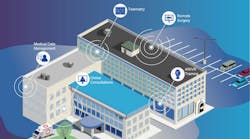Mitzi Amon, Director of Healthcare Marketing at Vertiv, explores the rising importance of healthcare edge infrastructure as Telehealth services surge amid the COVID-19 pandemic.
Mitzi Amon, Director of Healthcare Marketing, Vertiv
The spike in telehealth services that occurred during the early stages of the pandemic has been so sharp it’s almost hard to comprehend. Healthcare IT News reported that NYU Lagone Health, an academic medical center in Manhattan, saw a 683% increase in virtual urgent care visits and an astounding 4,345% increase in non-urgent virtual care visits between March 2 and April 14, 2020.
While this hospital was at the epicenter of the pandemic at that time, their experience isn’t unique. The Columbus Dispatch reported that Ohio-based Nationwide Children’s Hospital, which had only 19 virtual visits in all of 2019, performed more than 45,000 telehealth visits between March 1 and May 20, 2020.
While growth of this speed and magnitude is bound to stress almost any system, healthcare delivery networks have responded to these huge shifts in how care is delivered with agility, ingenuity and professionalism. Frontline healthcare workers have rightly received praise for their heroic response to this crisis, but healthcare IT professionals also deserve recognition for their behind-the-scenes efforts to enable their hospitals and clinics to continue to serve their communities during this unprecedented time.
A New Frontier
Today there is almost universal agreement that the surge in telehealth services triggered by the pandemic marks a turning point in how healthcare will be delivered in the future. Usage of telehealth services will never return to previous levels, forcing continued evolution in the technology that supports these systems. This need will only be enhanced by complementary growth in patient monitoring technologies, Internet of Medical Things (IoMT) and the emergence of 5G.
As CMS Administrator Seema Verma recently noted: “I think it’s fair to say that the advent of telehealth has been just completely accelerated, that it’s taken this crisis to push us to a new frontier, but there’s absolutely no going back.”
The challenges of continuing to meet the short-term demand for telehealth while beginning the process of planning for a future in which telehealth moves from the margins to the center of healthcare delivery are formidable.
The Role of the Healthcare IT Edge
Adapting to these changes in the near- and long-term will put more stress on healthcare IT networks and the professionals who manage them.
The first step for many delivery networks will likely be fortifying and enhancing the systems pulled together during the crisis. Does the hospital have the bandwidth to support sustained, elevated demand for telehealth services? Are telehealth systems as integrated with the EHR and PACS systems as they need to be? Are they able to consistently deliver the quality and availability these services require to play a more significant role in patient care?
Addressing these questions requires a careful evaluation of how the loss of internet or power will impact the patient experience, and the ability of existing infrastructure to meet the expanding demands of virtual and telehealth services.
In many cases, dated infrastructure, particularly in distributed locations, simply won’t be up to the challenge. Solutions will range from the relatively simple, such as adding compact uninterruptible power supplies (UPS) to mobile and desktop telehealth systems, to the more complex, including infrastructure upgrades and the addition of new IT hardware to support the increased bandwidth and higher data volumes resulting from telehealth and other emerging technologies.
This is a demanding but exciting time for healthcare IT professionals. The challenges of continuing to meet the short-term demand for telehealth while beginning the process of planning for a future in which telehealth moves from the margins to the center of healthcare delivery are formidable. At the same time, by managing that challenge, healthcare IT professionals will deliver extraordinary value to clinicians, patients, and the delivery networks they support.
Mitzi Amon is Director of Healthcare Marketing at Vertiv.
At Vertiv, we’ve developed a new resource for healthcare IT professionals considering changes to distributed infrastructure. Our Infrastructure Configuration Guide for Healthcare Network Closets, is designed to help IT professionals tailor distributed infrastructure to deliver the scalability and reliability required to support the future of healthcare delivery. Additional information and resources can also be found at vertiv.com/telehealth.





